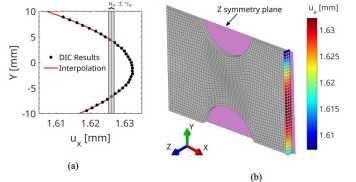New Paper on Post-Necking full-field FEMU identification
Our new paper on "Post-Necking full-field FEMU indentification of anisotropic plasticity from flat notsched tension experiments" was published in International Journal of Solids and Structures
Abstract

This work introduces a finite element model updating (FEMU) identification scheme to determine the material parameters of an anisotropic metal plasticity model. Surround digital image correlation (DIC) data is collected from tensile tests on mildly notched flat specimens and it is used to minimize specimen alignment errors when comparing simulations and experiments. The front surface displacement fields and resultant force history are leveraged to calibrate a Whip-Bezier based material model in a computationally-efficient procedure, which treats the pre- and post-necking regimes separately. Experimental data from specimens with a larger notch radius (NT20) serve as the training set, while data from specimens with a smaller notch radius (NT6) are used for validation. Analysis of identification methods using datasets from virtual experiments highlights the improved generalization ability of the full-field approach compared to solely using force–displacement curves. However, this work also demonstrates that through-thickness necking in real notched tensile experiments is asymmetric. This can hinder the identification of the large strain segment of hardening laws, especially when a FEMU approach incorporates full-field information from one specimen surface only. Consequently, it is recommended to use advanced finite element models that capture asymmetric localized strain fields or to base the identification of large strain hardening responses on experiments that achieve large strains without asymmetric through-thickness strain localization, such as in-plane torsion tests.